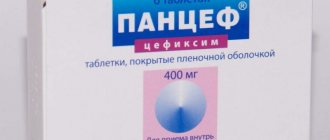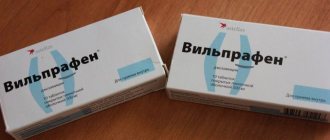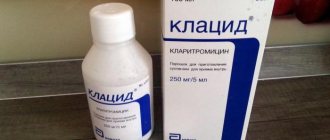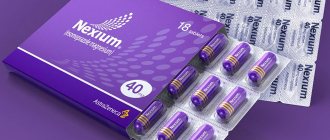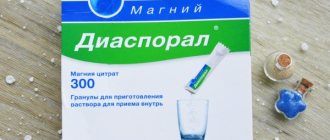Pain is characteristic of many diseases. They occur especially often when the osteoarticular system is damaged and due to domestic injuries. To alleviate the suffering of the patient and relieve local inflammation, Nise is often prescribed.
It significantly helps patients get rid of the symptoms of the disease. However, the drug is not flawless; Nise causes serious side effects, including life-threatening ones
Nise - tablet composition
The active ingredient of the described medication is nimesulide in an amount of 100 mg per pill. This substance is a non-steroidal chemical compound from the sulfonanilide group. It inhibits the production of enzymes that are involved in the synthesis of mediators of pain, swelling and inflammation. There are also auxiliary components added to Nise - the composition includes:
- calcium hydrogen phosphate;
- corn starch;
- microcrystalline cellulose type 114;
- sodium carboxymethyl starch;
- magnesium stearate;
- colloidal silicon dioxide;
- purified talc.
Reviews
On the Internet, users actively share their opinions regarding the use of the drug “Nise”. Most people like this medicine as it does its job effectively. Some users say that of all the painkillers they tried, only these tablets worked for them. According to reviews, the medication works best for headaches and joint pain. The first, as a rule, disappears forever, and the second - for at least six hours. There are people who note a twelve-hour effect of the drug. In the case of toothache, as users say, the remedy worked for several hours, then for many the unpleasant sensations returned.
People also testify that “Nise,” in addition to pain relief, also reduces high fever very well.
Among the disadvantages is the slow onset of action of the tablets. The analgesic effect is achieved only thirty to sixty minutes after taking the drug. In this case, immediate relief does not occur - the pain is relieved gradually. Many users do not like that the drug harms the stomach and causes side effects when combined with other medications.
In general, people recommend this product for use as a reliable and proven analgesic.
Nise tablets - what helps?
The pharmacological agent in question is prescribed only for symptomatic therapy; it does not affect the causes of the disease and its course. Nise tablets – indications for use:
- toothache and headache;
- algodismenorrhea;
- sciatica;
- pain in the postoperative period;
- arthralgia;
- bursitis;
- post-traumatic pain;
- inflammation of soft tissues, tendons and ligaments;
- myalgia of rheumatic and other origins;
- febrile syndrome;
- neuralgia.
Medical studies have shown that nimesulide not only eliminates pain, swelling and inflammation, but also prevents damage to cartilage tissue and stops the destruction of collagen. Thanks to this action, there are a number of musculoskeletal pathologies for which Nise is also effective, the indications for use of which are as follows:
- articular syndrome during gouty exacerbations;
- rheumatoid and psoriatic arthritis;
- osteochondrosis;
- ankylosing spondylitis;
- radicular syndrome;
- osteoarthritis;
- tenosynovitis;
- Bekhterev's disease;
- spinal pain due to scoliosis and other diseases;
- osteoarthritis;
- tendinitis;
- radiculitis;
- pain due to osteoporosis.
Description of the drug
"Nise" is a non-steroidal anti-inflammatory drug from the sulfonanilide class. It has an anti-inflammatory, pronounced antipyretic and analgesic effect.
It is a COX-2 inhibitor, slows down the synthesis of prostaglandins in the focus of inflammation and in the ascending pathways of the nociceptive system. Reduces the accumulation of short-lived prostaglandin H2, which, under the action of prostaglandin isomerase, is converted into prostaglandin E2. A decrease in its concentration leads to a decrease in the activity of prostanoid receptors of the EP type, which is expressed in anti-inflammatory and analgesic effects.
By inhibiting the synthesis of thromboxane A2 and endoperoxides, the drug suppresses platelet aggregation. Inhibits the release of histamine and reduces the degree of bronchospasm, which is caused by exposure to acetaldehyde and histamine.
It has been shown that Nise can suppress the synthesis of urokinase and interleukin-6, thereby preventing the destruction of cartilage tissue. Produces an antioxidant effect; by suppressing the activity of myeloperoxidase, it inhibits the formation of oxygen decomposition toxins.
The medication is intended for symptomatic treatment, reduction of inflammation, pain relief at the time of use. Does not affect the progression of pathology.
How to take Nise tablets?
The presented drug acts quickly and effectively, but it is important to follow the recommendations for its use. It is advisable to first consult with a doctor before taking Nise - using the medicine in the wrong dosage can cause negative side effects. Additionally, it is necessary to clarify the duration of the therapeutic course.
At what age can you take Nise?
The described medication is prescribed mainly to adults. Adolescents over 12 years of age with a body weight of 40 kg or more can take Nise tablets in the standard dosage of 100 mg. If the weight is less, the amount of nimesulide is calculated at 3-5 mg per 1 kg. The drug in question is not prescribed to children under 3 years of age. If the child has reached the specified age, it is allowed to use dispersible Nise - tablets for children that dissolve in water. They are available in a dosage of 50 mg of the active ingredient in each pill.
How to take Nise for toothache?
An anti-inflammatory agent based on nimesulide is used to relieve discomfort before and after dental procedures. In these situations, Nise is prescribed according to the classical scheme - tablets for toothache are taken 2 times a day, 1 piece (100 mg). The maximum daily dosage is 200 mg. Experts advise taking pills before meals, but if you experience discomfort in the stomach or intestines, it is better to use Nise tablets after a meal. The duration of the course is calculated individually, but should not exceed 15 days.
How to take Nise for osteochondrosis?
Back pain, inflammation and swelling are also effectively relieved by nimesulide. If osteochondrosis relapses, the standard method of taking Nise is prescribed - 100 mg 2 times a day. Similarly, tablets are used for symptomatic treatment of other musculoskeletal pathologies with pain syndrome. The duration of treatment is determined depending on the severity of clinical signs, mainly 7-12 days.
Can I take Nise for a headache?
The presented pharmacological remedy helps with the problem in question, but not always. Nise painkillers are recommended only if an attack occurs against the background of:
- increased body temperature;
- inflammatory processes, for example, meningitis;
- tension;
- overwork;
- stress;
- lack of sleep;
- changes in weather conditions;
- toothache;
- blows and bruises;
- surgical interventions;
- medical procedures;
- noise;
- blood pressure surges;
- osteochondrosis;
- pinched nerve roots and other factors.
Nise tablets are ineffective if the cause of the pain is migraine. In this case, no anti-inflammatory non-steroidal medications will help. For migraine attacks, it is better to take medications that have a direct effect directly on the dilated blood vessels in the brain and block the sensitivity of the trigeminal nerve receptors. These medications include triptans.
How long does the Nise tablet last?
The duration of the analgesic and anti-inflammatory effect depends on the nature of the discomfort, its intensity and cause. Nise 100 mg tablets block discomfort for 0.5 days. The degree of pain relief gradually decreases, because nimesulide begins to be eliminated from the body after 2-5 hours. The maximum analgesic effect is observed 20-25 minutes after taking the tablet.
How many times a day can I take Nise?
The recommended frequency of use of the medication in question is limited to two times. In extremely rare situations, the doctor may allow you to take Nise tablets more often - the use of an anti-inflammatory drug is allowed in a maximum daily dosage of 400 mg. Exceptional cases when nimesulide is prescribed 4 times a day occur in surgical practice. After some operations, the severity of the pain syndrome is too intense, and in order to avoid a state of shock, the analgesic will be used in an increased dose.
How long can you take Nise tablets?
The duration of symptomatic therapy should correspond to the specific situation. Only a specialist decides how many days Nise can be taken. The maximum recommended duration of treatment is 15 days. More often, nimesulide is used until swelling and signs of inflammation disappear - 7-10 days or less. For headaches, menstrual pain, and toothache, the medication is used for 2-3 days or once.
Can Nise be taken with alcohol?
There are no direct instructions regarding the simultaneous use of nimesulide and the consumption of alcoholic beverages. Nise tablets help with headaches and fever associated with a hangover, quickly and effectively relieving the condition. Doctors just do not recommend using the described drug in parallel with strong drinks and on the eve of parties. Nise and alcohol are poorly compatible, because ethanol can retain fluid in the body. Along with it, nimesulide accumulates in the digestive system, which can provoke dangerous consequences.
Dosage and method of administration
For adults and children over the age of twelve, the drug “Nise” is prescribed orally in the dosage: one tablet twice a day. The medicine should be taken after meals and washed down with plenty of water. The maximum daily dose is 200 milligrams (two tablets). People with chronic renal failure need to reduce the dose to 100 milligrams per day. When treating with the drug, you must strictly follow the method of use indicated in the instructions. "Nise" should be used in the minimum effective dosage for the shortest possible course.
Nise tablets - side effects
The presented pharmacological agent is rarely accompanied by negative concomitant phenomena. Most tablets are well tolerated, less than 5% of patients cannot take Nise - side effects include:
- dizziness;
- nervousness;
- feeling of unreasonable fear;
- nightmares;
- drowsiness;
- swelling of the face;
- encephalopathy in the form of Reis' syndrome;
- headache;
- Lyell's syndrome;
- immune hypersensitivity reactions;
- skin rash (urticaria, eczema, dermatitis);
- anaphylactic shock;
- itching;
- increased sweating;
- exudative erythema multiforme;
- angioedema;
- Stevens-Johnson syndrome;
- toxic epidermal necrolysis;
- dysuria;
- hyperkalemia;
- urinary retention;
- hematuria;
- renal failure;
- interstitial nephritis;
- severe swelling of the extremities;
- oliguria;
- nausea;
- constipation;
- gastritis;
- flatulence;
- diarrhea;
- vomit;
- stomatitis;
- pain in the epigastric region;
- tarry soft stools;
- exacerbation of peptic ulcer, perforation of the stomach or duodenum;
- internal bleeding;
- hepatitis, including fulminant form;
- cholestasis;
- drug-induced jaundice;
- increased transaminase levels;
- eosinophilia;
- anemia;
- pancytopenia;
- increased duration of bleeding;
- thrombocytopenia;
- purpura;
- exacerbation of bronchial asthma attacks;
- dyspnea;
- bronchospasms;
- arterial hypertension;
- tides;
- tachycardia;
- blurred vision or deterioration in its clarity;
- hemorrhage;
- general weakness, decreased performance;
- a sharp decrease in body temperature.
People with certain medical conditions are at higher risk of developing these problems. In such situations, it is necessary to use Nise with extreme caution; side effects are more often observed in the following pathologies:
- dysfunction of the kidneys and bladder;
- eye diseases;
- high blood pressure;
- cardiovascular diseases;
- severe liver damage.
Nimesulide is capable of chemical reactions with other non-steroidal anti-inflammatory drugs, so the simultaneous use of Nise and similar analgesics may lead to undesirable side effects. It is not recommended to take the medication while planning pregnancy. The drug has been found to have a negative effect on female fertility.
Overdose
If you take Nise tablets in a dosage higher than that indicated in the instructions, overdose symptoms may develop: drowsiness, apathy, vomiting, nausea. Blood pressure may increase, acute renal failure or gastrointestinal bleeding may occur, and respiratory depression may occur.
In case of overdose, the patient requires symptomatic treatment and supportive care. There is no specific antidote. If poisoning occurred within the last four hours, you need to induce vomiting, take osmotic laxatives and activated carbon in an amount of 6-10 grams. Due to the high binding of the drug to proteins, hemodialysis and forced diuresis are ineffective.
Nise tablets - contraindications
Some people are strictly prohibited from using the considered pharmacological agent Nise, the contraindications for use of which are as follows:
- a combination of recurrent nasal polyposis, paranasal sinuses or bronchial asthma and intolerance to acetylsalicylic acid or other non-steroidal painkillers;
- hypersensitivity to nimesulide or auxiliary ingredients of the drug;
- cerebrovascular, active gastric, intestinal or other bleeding;
- Crohn's disease in relapse stage;
- nonspecific ulcerative colitis during an exacerbation;
- decompensated heart failure;
- erosive or ulcerative lesions of the mucous membrane of the duodenum and stomach;
- hemophilia and other pathologies that alter blood clotting;
- any active liver disease, including liver failure;
- alcoholism;
- hyperkalemia;
- severe renal failure with creatinine clearance less than 30 ml/min;
- period after coronary artery bypass surgery;
- hepatotoxic reactions when prescribing drugs containing nimesulide;
- concurrent use of potentially hepatotoxic chemicals.
Nise analgesic tablets are not prescribed for physiological conditions not associated with diseases:
- pregnancy;
- breast-feeding;
- age up to 3 years.
Carefully
The drug "Nise" should be taken with caution by people with cerebrovascular pathologies, coronary artery disease, congestive heart failure, peripheral arterial disease, diabetes mellitus, severe somatic conditions, dyslipidemia or hyperlipidemia, as well as in old age, with frequent alcohol consumption and smoking. You should be careful when taking the medication with concomitant therapy with antiplatelet agents, anticoagulants and oral glucocorticosteroids.
Analogue of Nise in tablets
If the presented medication is not suitable, you can select an identical remedy. Nise pain tablets can be easily replaced with the following drugs:
- Nimesin;
- Remesulide;
- Nimid;
- Ameolin;
- Toro-Sanovel;
- Nimesulide;
- Alit;
- Pansulide;
- Negan;
- Aponil;
- Nanogan;
- Oxygen;
- Nimegesic;
- Affida;
- Nimuspaz;
- Mesulide;
- Nimulid;
- Sigan.
Generics (same effect, different active substance):
- Osteal;
- Arthromax;
- Piaskledin;
- Sinmeton;
- Ibuprofen;
- Mig-400;
- Citramon;
- Ketanov;
- Indomethacin;
- Diclofenac;
- Sulindak;
- Naproxen;
- Celecoxib.
Interaction with other medications
The effect of drugs that reduce blood clotting is enhanced when taken simultaneously with the active ingredient "Nise". Nimesulide can weaken the effect of furosemide. When used together with methotrexate, the likelihood of adverse reactions may increase.
If you take Nise together with lithium drugs, its plasma level will increase. Nimesulide may increase the effects of cyclosporine on the kidneys. When used simultaneously with glucocorticosteroids, the risk of gastrointestinal bleeding increases.
Pharmacokinetics
After consumption, it is well absorbed from the gastrointestinal tract, mostly from the intestines. Consumption of food reduces the extent of absorption, but does not affect the level of absorption. It has penetrating ability into the genitals of a woman’s body, where after one use the nimesulide content is approximately 40% of that in the blood plasma. It also penetrates well into the acidic environment of the center of the inflammatory process, periarticular exudate and internal barriers.
The highest concentration in the circulatory system is observed after 2.5 hours, and the connection with protein molecules reaches 95%.
The metabolic process in the body of nimesulide is carried out in the liver. The half-life is about 5 hours. Metabolic products are excreted by the kidneys and bile secretions.
Instructions for the gel
This form is released exclusively for external use:
- Before applying the product, ensure that the treated area is clean and dry.
- From the tube you need to squeeze out a column of gel of approximately 3 centimeters.
- It must be applied to the skin without rubbing up to four times a day.
If a large area of skin needs to be treated, the use of Nise gel should be reduced. It is important to avoid getting the product into the mucous membrane area. The therapeutic course is up to 10 days.
Release form
The drug is available in several dosage forms:
- Nise tablets containing 100 mg of the active ingredient nimesulide, 10 pieces in a blister;
- Nise dispersible tablets containing 50 mg of the active ingredient nimesulide, 10 pieces in a blister;
- Suspensions for oral administration, 5 ml - 50 mg of nimesulide, in 60 ml bottles with a dosage cap;
- Gel Nise 1% for external use, 1 g - 10 mg of nimesulide, in aluminum tubes of 20 g.

